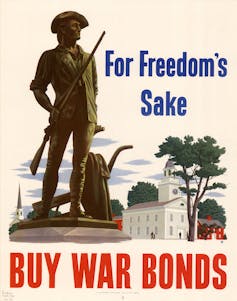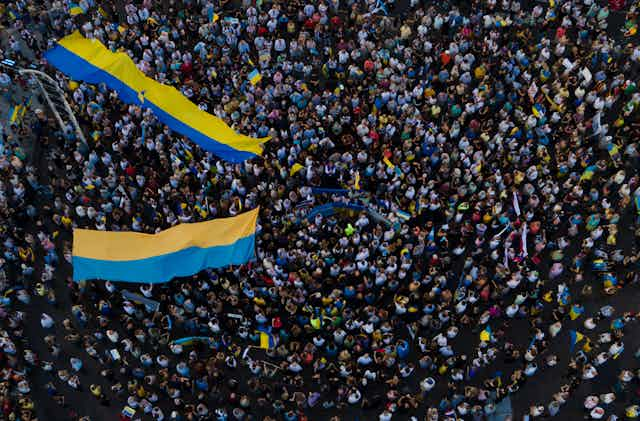Ukraine is desperate for money. And as the saying goes, freedom is not free.
The Ukrainian Ministry of Finance – at this moment trying to fund the nation’s defense against a massive Russian invasion – would surely agree. That’s one reason the Ukrainian government recently took a page from the 20th-century playbook by issuing war bonds. So far, Ukraine has raised 8.1 billion hryvnias (US$270 million) selling war bonds that pay interest of 11%.
My research on the U.S. war bond program during World War II shows why this initiative has great potential. It also suggests that the Ukrainian war financing effort could go further.
Paying for war
The concept has deep roots that go back long before the two world wars.
Historically, nations have funded war operations in a variety of ways, from war taxes to selling plunder and taking out debilitating loans. Yet by the Napoleonic era, the British had adopted a more strategic process of issuing “consol” debt as a means of borrowing war funds, typically from larger financial institutions.
During the U.S. Civil War, Secretary of the Treasury Salmon P. Chase went one step further. Aiming to distribute the government’s war debt more broadly, he recruited a domestic army of bond salespeople. Their aim was to convince individual citizens to purchase bonds as a personal investment.
It was a relatively simple financial bargain: The government would use the money to prosecute the war, while the citizen would receive an elaborate paper bond issued by the Treasury. Once the bond matured, or so the pitch went, the government promised to pay back the principal with interest, with anticipated returns of 5% to 7%. Incredibly, the Lincoln administration raised over $2 billion with this new sales approach, or about $37 billion in today’s dollars.
Unfortunately, since the value of the bonds fluctuated, sluggish postwar economic growth diminished much of the actual return for investors.
Bonds as propaganda
On the eve of American involvement in World War I, the Treasury added an important new element to its bond financing operations.
Treasury Secretary William G. McAdoo, studying Chase’s Civil War program, faulted his predecessor for restricting his sales pitch to financial motives rather than tapping into a more political or emotional motivation. As McAdoo argued, “Chase did not attempt to capitalize on the emotion of the people, yet it was there and he might have put it to use.”
The World War I program thus became a pervasive, all-out propaganda operation for the U.S. war effort. The bonds became “Liberty Bonds,” and the Treasury’s salespeople became “Four Minute Men,” who were trained to make their pitch at local cinemas during the standard four-minute gap between feature movie reels.
The financial motivation, with anticipated returns varying from 3% to 4%, was still an important part of the effort. Yet this time, the propaganda aspects took center stage.
The Committee on Public Information, the Wilson administration’s domestic propaganda agency, staged four nationwide Liberty Loan drives that saturated citizens with patriotic appeals and imagery. For George Creel, head of the agency, the effort was nothing less than a “fight for the minds of men,” one that was equal in importance to the fighting on the battlefield. The initiative raised over $21 billion – or $393 billion today. In terms of their ability to trigger a wartime mentality on the home front, these efforts were generally successful.
Unfortunately, they too often veered into outright coercion. Citizens who could not afford bonds were frequently branded as traitors. In rural areas, such so-called slackers occasionally found that their barn or home had been painted yellow overnight to indicate betrayal. Others were forced to purchase bonds against their will. The public shaming was so intense that some Americans even went into personal debt to be seen buying a Liberty Bond.
Promoting patriotism, without coercion
A generation later, Treasury Secretary Henry F. Morgenthau Jr. deplored the unpleasant memories of the coercive Liberty Bond program.
As the United States once again equipped itself for a world war, he unveiled a kinder, gentler war finance operation. Unlike its immediate predecessor, the new program would be grounded in persuasion, not coercion or shaming. Its products weren’t Liberty Bonds but the more moderately termed Defense Bonds – though after Pearl Harbor, they became War Bonds. And its primary symbol became Daniel Chester French’s Minute Man sculpture, a popular representation of people doing their part in mobilizing for war.

Even so, the twofold mission of McAdoo’s World War I operation was still present. On the one hand, it was a financial undertaking. The emerging war would surely be spectacularly expensive for the United States, and so by distributing the nation’s war debt across millions of citizen investors, the country’s economy would be on a sounder footing.
[Understand key political developments, each week. Subscribe to The Conversation’s politics newsletter.]
On the other hand, it was also intrinsically propagandistic, seeking to use the war bond sales force and its countless posters, billboards, ads and radio spots as a relentless means of domestic persuasion on behalf of the war.
“I can think of no other single way,” Morgenthau noted, “in which so many people can become partners of their Government in facing this emergency. It is the purpose of the Treasury to raise money for national defense by methods which strengthen the national morale.”
This twofold approach was, by almost any standard, a success, leading to over $185 billion in sales, worth about $2.9 trillion now.
Ukraine’s war bonds
Today, Ukraine’s war bond operation is still unfolding, but it clearly inherits much of this history.
Like every American war bond initiative since the Civil War, it’s most obviously a financial arrangement, allowing investors to loan money to the war effort in exchange for an eventual return – assuming, of course, that the bond issuer is on the winning side. There are even some propagandistic elements involved in the effort, if only because Ukraine’s war bond sale was announced on Twitter and has fueled enthusiastic inquiries.
Still, the operation so far appears to be limited to larger investors, such as banks and investment firms.
If the Ukrainians target individual investors, both domestic and international, they might find a lot more buyers. Investing in what many consider to be a noble resistance effort would likely resonate across the free world.

